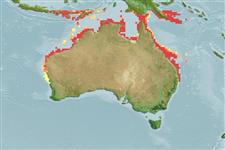Environment: milieu / climate zone / depth range / distribution range
Ecologia
marinhas; estuarina demersal; não migratória; intervalo de profundidade 0 - 10 m (Ref. 6205). Tropical; 8°S - 30°S, 110°E - 157°E (Ref. 6205)
Western Central Pacific: northern Australia, from Shark Bay, Western Australia to Moreton Bay, Queensland. Also known from the southern coast of New Guinea. Sillago nierstraszi is almost certainly a synonym of this species.
Tamanho / Peso / Idade
Maturity: Lm ? range ? - ? cm
Max length : 45.0 cm SL macho/indeterminado; (Ref. 6205); common length : 35.0 cm SL macho/indeterminado; (Ref. 9679)
Espinhos dorsais (total): 12; Raios dorsais moles (total): 16-18; Espinhos anais 2; Raios anais moles: 14 - 17; Vértebras: 33 - 34. The shape of the swim bladder is not distinguishable from that of S. ciliata. The anterior part of the swim bladder has rudimentary tubules projecting anteriorly and a lateral series, that diminishes in size and becoming sawtooth-like, projecting posteriorly. Body is light silvery, slightly darker to dusky dorsally. A dull golden silver to golden yellow stripe is below the lateral line. The pelvic and anal fins are pale yellow to bright yellow; the pectoral fin has a darker dusting of fine black-brown spots.
Juveniles of this species, together with those of S. schomburgkii remain in warm waters of the shallow mangrove creek shorelines and protected inlets. Mature S. analis prefer the muddy, tidal streams. The preferred prey are crustaceans. They also rummage in the silty-sand substrates for worms and have been observed to 'plough' up the bottom with the snout (Ref. 6205). Oviparous (Ref. 205).
Life cycle and mating behavior
Maturidade | Reprodução | Desova | Ovos | Fecundidade | Larvas
McKay, R.J., 1992. FAO Species Catalogue. Vol. 14. Sillaginid fishes of the world (family Sillaginidae). An annotated and illustrated catalogue of the sillago, smelt or Indo-Pacific whiting species known to date. Rome: FAO. FAO Fish. Synop. 125(14):87p. (Ref. 6205)
Categoria na Lista Vermelha da IUCN (Ref. 130435)
Ameaça para o homem
Harmless
Utilização humana
Pescarias: espécies comerciais; Aquacultura: uso futuro provável
Mais informação
Nomes comunsSinónimosMetabolismoPredadoresEcotoxicologiaReproduçãoMaturidadeDesovaAgregação para desovaFecundidadeOvosDesenvolvimento dos ovos
ReferênciasAquaculturaPerfil para aquaculturaEstirpesGenéticaElectrophoresesHereditariedadeDoençasProcessamentoNutrientsMass conversion
ColaboradoresFotografiasStamps, Coins Misc.SonsCiguateraVelocidadeTipo de nataçãoÁrea branquialOutras referênciasCérebrosVisão
Ferramentas
Relatórios especiais
Descarregue XML
Fontes da internet
Estimates based on models
Preferred temperature (Ref.
123201): 24.6 - 28.7, mean 27.8 °C (based on 560 cells).
Phylogenetic diversity index (Ref.
82804): PD
50 = 0.5000 [Uniqueness, from 0.5 = low to 2.0 = high].
Bayesian length-weight: a=0.00851 (0.00366 - 0.01979), b=3.07 (2.86 - 3.28), in cm total length, based on LWR estimates for this (Sub)family-body shape (Ref.
93245).
Nível Trófico (Ref.
69278): 3.3 ±0.1 se; based on diet studies.
Generation time: 2.2 ( na - na) years. Estimated as median ln(3)/K based on 1
growth studies.
Resiliência (Ref.
120179): Elevada, tempo mínimo de duplicação da população menor que 15 meses (Preliminary K or Fecundity.).
Fishing Vulnerability (Ref.
59153): Low to moderate vulnerability (28 of 100).
